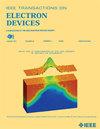用带声子散射的交流非平衡格林函数法研究太赫兹频率p型FinFET中交流量子输运的自热效应
IF 2.9
2区 工程技术
Q2 ENGINEERING, ELECTRICAL & ELECTRONIC
引用次数: 0
摘要
本文通过将直流量子输运和热传导模拟得到的温度分布引入考虑声子散射的交流非平衡格林函数中,进行多物理场模拟,研究p型FinFET交流量子输运的自热效应(SHE)。采用三波段$\boldsymbol {k}\cdot \boldsymbol {p}$哈密顿和自洽玻恩近似方法分别捕获了复杂的价带和空穴声子散射。通过自洽地求解泊松方程和交流非平衡格林函数方程,除考虑传导电流外,还考虑了交流电流密度中的位移电流。研究了SHE对Y参数、小信号电流增益和截止频率的影响,并通过分析交流电流密度谱和空穴密度谱,探讨了相应的物理机制。仿真结果表明,SHE可以通过影响${Y}_{\text {DG}}$而不是${Y}_{\text {GG}}$来影响小信号电流增益和截止频率。对于栅极电压幅值小于0.4 V的器件,由于SHE增强了空穴能量,可以更容易地穿过或隧穿势垒,从而增加了${Y}_{\text {DG}}$的幅值,从而提高了截止频率和小信号电流增益。而对于栅极电压幅值大于0.5 V的器件,由于孔声子散射的增强使${Y}_{\text {DG}}$的幅值减小,小信号电流增益和截止频率降低。本文章由计算机程序翻译,如有差异,请以英文原文为准。
Theoretical Investigation of Self-Heating Effect on AC Quantum Transport in p-Type FinFET in THz Frequency by AC Non-Equilibrium Green’s Function Method With Phonon Scattering
In this article, a multiphysics simulation is performed to investigate the self-heating effect (SHE) on p-type FinFET ac quantum transport by introducing the temperature distribution obtained from dc quantum transport and heat conduction simulation into the ac non-equilibrium Green’s function with consideration of phonon scattering. The complicated valence band and hole-phonon scattering are captured by employing three-band $\boldsymbol {k}\cdot \boldsymbol {p}$ Hamiltonian and self-consistent Born approximation approach, respectively. The displacement current is considered in ac current density in addition to the conduction current by solving the Poisson equation and the ac non-equilibrium Green’s function (NEGF) equations self-consistently. The impact of the SHE on Y parameters, small-signal current gains, and cutoff frequency is investigated, and the corresponding underlying physical mechanism is also investigated by analyzing the ac current density spectrum and hole-density spectrum. The simulation results show that the SHE can affect the small-signal current gain and cutoff frequency by affecting ${Y}_{\text {DG}}$ rather than ${Y}_{\text {GG}}$ . For the device operated with gate voltage magnitude less than 0.4 V, the cutoff frequency and small-signal current gain can be increased because the hole energy is enhanced by the SHE, which means they can more easily cross or tunnel through the barrier, thereby increasing the amplitude of ${Y}_{\text {DG}}$ . In contrast, for the device operated with gate voltage magnitude greater than 0.5 V, the small-signal current gain and the cutoff frequency are decreased because the amplitude of ${Y}_{\text {DG}}$ is decreased by the enhanced hole-phonon scattering.
求助全文
通过发布文献求助,成功后即可免费获取论文全文。
去求助
来源期刊

IEEE Transactions on Electron Devices
工程技术-工程:电子与电气
CiteScore
5.80
自引率
16.10%
发文量
937
审稿时长
3.8 months
期刊介绍:
IEEE Transactions on Electron Devices publishes original and significant contributions relating to the theory, modeling, design, performance and reliability of electron and ion integrated circuit devices and interconnects, involving insulators, metals, organic materials, micro-plasmas, semiconductors, quantum-effect structures, vacuum devices, and emerging materials with applications in bioelectronics, biomedical electronics, computation, communications, displays, microelectromechanics, imaging, micro-actuators, nanoelectronics, optoelectronics, photovoltaics, power ICs and micro-sensors. Tutorial and review papers on these subjects are also published and occasional special issues appear to present a collection of papers which treat particular areas in more depth and breadth.
 求助内容:
求助内容: 应助结果提醒方式:
应助结果提醒方式:


